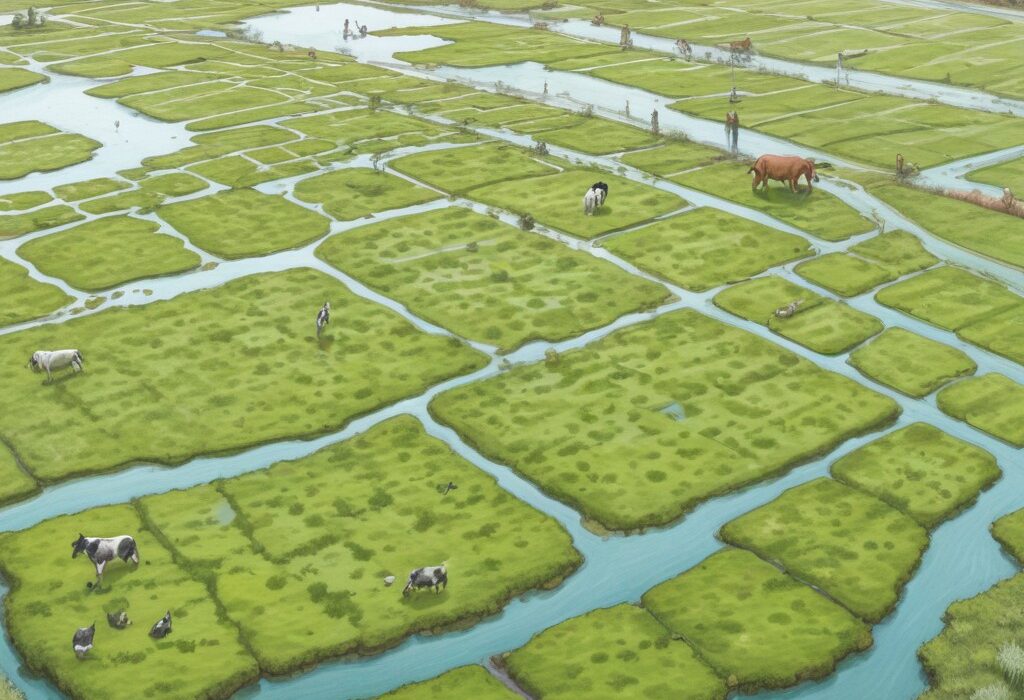Azolla Fodder: A Climate-Smart Solution for Modern Agriculture
Introduction
As the effects of climate change become increasingly evident, the need for climate-smart agricultural solutions has never been more urgent. Modern agriculture must adapt to changing climatic conditions, mitigate its environmental impact, and enhance resilience to ensure food security. Azolla fodder, a small aquatic fern with remarkable properties, offers a promising climate-smart solution. This article explores how Azolla contributes to climate-smart agriculture by improving resource efficiency, reducing greenhouse gas emissions, and promoting sustainable farming practices.
The Climate Challenge
Climate change poses significant challenges to agriculture, including extreme weather events, changing precipitation patterns, and rising temperatures. These changes can negatively impact crop yields, water availability, and soil health, threatening food security and farmers’ livelihoods. To address these challenges, agriculture must adopt practices that are resilient to climate variability and minimize environmental impact.
Azolla’s Resource Efficiency
One of the key attributes of Azolla that makes it a climate-smart solution is its efficient use of resources. Azolla can be cultivated in shallow ponds or waterlogged fields, requiring significantly less water than traditional crops. This makes it an ideal feed option for regions facing water scarcity. By conserving water, Azolla helps farmers adapt to changing water availability and reduces the pressure on this vital resource.
Moreover, Azolla’s rapid growth rate and high biomass production ensure a continuous supply of nutritious feed with minimal inputs. It doubles its biomass every 2-3 days under optimal conditions, providing a sustainable and efficient feed source. This high productivity reduces the need for large land areas and allows farmers to make the most of their available resources.
Reducing Greenhouse Gas Emissions
Agriculture is a significant contributor to greenhouse gas emissions, particularly through the use of synthetic fertilizers, methane emissions from livestock, and land-use changes. Azolla can help mitigate these emissions through several mechanisms.
Firstly, Azolla’s ability to fix atmospheric nitrogen reduces the need for synthetic nitrogen fertilizers, which are associated with high greenhouse gas emissions during their production and application. By providing a natural source of nitrogen, Azolla promotes sustainable nutrient management and reduces the carbon footprint of farming operations.
Secondly, Azolla cultivation can contribute to carbon sequestration. As a fast-growing plant, Azolla absorbs carbon dioxide from the atmosphere and stores it in its biomass. When used as green manure or livestock feed, the carbon remains sequestered in the soil or within the livestock system, helping to offset emissions and mitigate climate change.
Promoting Sustainable Farming Practices
Azolla supports sustainable farming practices by enhancing soil health, conserving water, and reducing the reliance on chemical inputs. Its use as green manure enriches the soil with organic matter and nutrients, promoting healthy soil ecosystems and improving crop yields. This reduces the need for chemical fertilizers and pesticides, which can have negative environmental impacts.
Furthermore, Azolla’s cultivation promotes biodiversity by providing habitat for various aquatic organisms and supporting natural pest control. By integrating Azolla into their farming systems, farmers can create more resilient and sustainable agricultural landscapes that are better equipped to withstand the impacts of climate change.
Enhancing Climate Resilience
Climate-smart agriculture aims to enhance the resilience of farming systems to climate variability and extreme events. Azolla contributes to this resilience by providing a reliable and adaptable feed source. Its rapid growth and ability to thrive in diverse environmental conditions ensure a steady supply of high-quality feed, even in challenging climatic conditions.
Farmers who cultivate Azolla can buffer their livestock against feed shortages during droughts or other extreme weather events. This enhances the overall resilience of their farming operations, ensuring food security and economic stability in the face of climate change.
Case Studies and Global Impact
The impact of Azolla as a climate-smart solution is evident in various case studies around the world. In Southeast Asia, for example, rice farmers have successfully integrated Azolla into their cropping systems to enhance soil fertility and reduce methane emissions from rice paddies. In Africa, smallholder farmers are using Azolla to improve livestock nutrition and reduce feed costs, contributing to climate resilience and food security.
These case studies highlight the versatility and effectiveness of Azolla in promoting climate-smart agriculture. By leveraging the benefits of Azolla, farmers can adopt practices that are both environmentally sustainable and economically viable, supporting global efforts to combat climate change.
Challenges and Opportunities
Despite its many advantages, the widespread adoption of Azolla faces challenges such as the need for education and training on cultivation techniques, potential pest and disease issues, and initial setup costs. Addressing these challenges requires collaboration between researchers, extension services, and policymakers to provide the necessary support and resources.
Opportunities for expanding the use of Azolla include integrating it into climate-smart farming practices, developing value-added products, and exploring new applications in agriculture and beyond. Continued research and innovation will help unlock the full potential of Azolla as a climate-smart solution.
Conclusion
Azolla fodder offers a climate-smart solution for modern agriculture by improving resource efficiency, reducing greenhouse gas emissions, and promoting sustainable farming practices. Its numerous benefits make it an ideal feed option for farmers seeking to adapt to climate change and enhance the resilience of their farming systems. By embracing Azolla cultivation, we can support sustainable agriculture, mitigate the impacts of climate change, and ensure a secure and resilient food supply for the future.





3 Comments
The Common category includes then following block: Paragraph, image, heading, latest gallery, quote, audio, cover, video. The paragraphs block is the default block type. This is should not have any alignment of any kind. Category and then there are many things to following blocks and many more.
The Common category includes then following block: Paragraph, image, heading, latest gallery, quote, audio, cover, video. The paragraphs block is the default block type. This is should not have any alignment of any kind.
The Common category includes then following block: Paragraph, image, heading, latest gallery, quote, audio, cover, video. The paragraphs block is the default block type. This is should not have any alignment of any kind. Category and then there are many things too following blocks and many more.